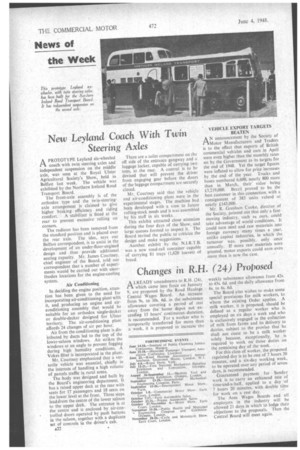New Leyland Coach With Twin Steering Axles
Page 24

If you've noticed an error in this article please click here to report it so we can fix it.
APROTOTYPE Leyland six-wheeled coach with twin steering axles and independent suspension on the middle axle, was seen at the Royal Ulster Agricultural Society's Show, held in Belfast last week. The vehicle was exhibited by the Northern Ireland Road Transport Board.
The front-axle assembly is of the orthodox type and the twin-steeringaxle arrangement is claimed to give higher braking efficiency and riding comfort. A stabilizer is fitted at the rear to prevent excessive rolling on corners.
The radiator has been removed from the standard position and is placed over the rear axle. The idea, says our Belfast correspondent, is to assist in the development of an under-floor-engined design and thus provide additional seating capacity. Mr. James Courtney. chief engineer of the Board, told our correspondent that a number of experiments would be carried out with unorthodox locations for the engine-cooling system.
Air Conditioning In deciding the engine position, attention has been given to the need for incorporating air-conditioning plant with it, and producing an engine and airconditioning assembly that would be suitable for an orthodox single-decker or double-decker designed for Ulster territory. The air-conditioning plant affords 24 changes of air per hour.
Air from the conditioning plant is distributed by ducts led to the top of the lower-saloon windows. Air strikes the windows at an angle to prevent fogging during high humidity conditions. A Vokes filter is incorporated in the plant.
Mr. Courtney emphasized that a versatile vehicle was essential, chiefly in the interests of handling a high volume of parcels traffic in rural areas.
The body was designed and built by the Board's engineering department. It has a raised upper deck at the rear with seats for 17 passengers and 18 seats on the lower level at the front. Three steps lead,from the centre of the lower saloon to the upper deck. The entrance is at the centre and is enclosed by air-controlled doors operated by push buttons in the saloon, together with a duplicate set of controls in the driver's cab.
A22
There are a toilet compartment on tht: off side of the entrance gangway and a luggage locker, capable of carrying two tons, at the rear. A control is to bc devised that will prevent the driver from engaging gear before the doors of the luggage compartment are securely closed.
Mr. Courtney said that the vehicle and air-conditioning plant were in the experimental stages. The machine had been developed with a view to future rolling-stock needs and it was assembled by his staff in six weeks.
This exhibit attracted close attention during the four days of the Show, and large queues formed to inspect it. The Board invited the public to criticize the design and make suggestions.
Another exhibit by the N.1.R.T.B. was a new road-rail container capable of carrying 81 trays (1,620 loaves) of bread. VEHICLE EXPORT TARGETS BEATEN
AN announcement by the Society of Motor Manufacturers and Traders is to the effect that exports of British commercial vehicles and cars in April were even higher than the monthly rates set by the Government as its targets for the end of 1948. Yet the target figures were inflated to allow for price increases by the end of the year. Trucks and buses numbered 6,600, nearly 800 more than in March, their value being £3,219,000. Brazil proved to be the best customer in this connection. with a consignment of 383 units valued at nearly £143,000.
Mr. R. Gresham Cooke, director of the Society, pointed out that only a fastmoving industry, such as ours, could take advantage of world conditions. It could turn steel and raw materials into foreign currency many times a year, unlike capital industries, in which the turnover was, possibly, only once annually. If more raw materials were granted, motor exports could earn even more than is now the case.
















































































